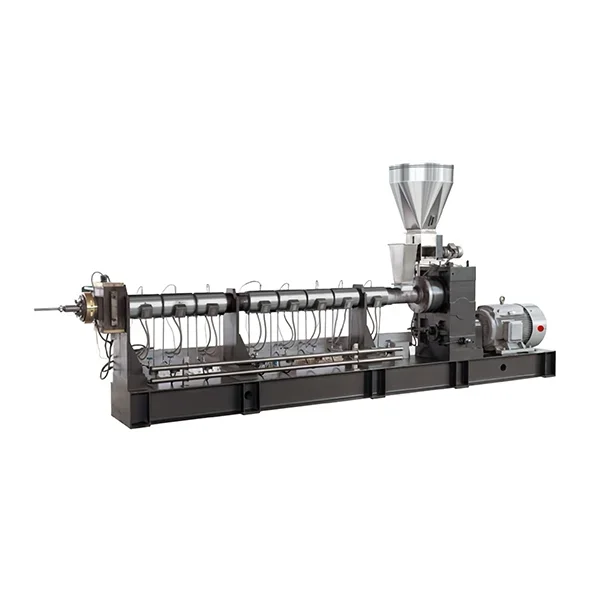How Single Screw Extruders Work: A Comprehensive Guide
Single screw extruders are vital machines in the plastics industry, playing a crucial role in processing various materials into usable products. From films and tubes to plates and granules, these machines are designed to handle a wide range of applications efficiently. At JiaXin, we specialize in high-quality single screw extruders that meet diverse manufacturing needs. This comprehensive guide will explore how single screw extruders work, their components, and their applications.

What is a Single Screw Extruder?
A single screw extruder is a type of machine used to melt and shape plastic materials through a continuous process. It consists of a rotating screw within a heated barrel that conveys, melts, and forms the material into a desired shape as it exits through a die at the end of the barrel.
Key Components of a Single Screw Extruder
1. Feeding System: The feeding system is typically configured with a volumetric metering feeder or a plug-in hopper. This system ensures that the right amount of material enters the extruder for processing.
2. Main Motor: The extruder is powered by a high-efficiency AC variable frequency motor, which provides the necessary torque to rotate the screw.
3. Gearbox: A ZLYJ hardened gear reducer is used to transmit power from the motor to the screw. This gearbox is precision-machined from ductile iron, ensuring durability and reliability.
4. Screw and Cylinder: The screw is made from high-quality nitrided steel (38CrMoAlA) and undergoes nitriding treatment for enhanced hardness (HV950-1050). The cylinder is heated to facilitate melting and processing of the material.
5. Screen Changing Device: This component allows for hydraulic or manual screen changes without interrupting the extrusion process, ensuring continuous operation.
6. Electric Control Cabinet: Equipped with advanced controls for speed and temperature regulation, this cabinet includes high-quality components from reputable brands like Omron and Schneider.
7. Machine Base: The machine base is constructed from welded steel plate and channel steel, featuring shock-absorbing pads to minimize vibrations during operation.
How Does a Single Screw Extruder Work?
1. Material Feeding
The process begins with raw plastic material being fed into the hopper of the extruder. The volumetric feeder ensures a consistent flow of material into the barrel.
2. Melting Process
As the screw rotates, it moves the plastic material along the length of the barrel while simultaneously applying heat through heating zones. The combination of mechanical shear and heat causes the plastic to melt and become viscous.
3. Mixing and Homogenization
During this phase, any additives or colorants can be introduced into the melt stream. The design of the screw allows for thorough mixing and homogenization of materials, ensuring uniform properties in the final product.
4. Pressure Build-Up
As the melted material moves toward the die, pressure builds up within the barrel due to friction between the material and the barrel walls as well as between adjacent layers of molten plastic.
5. Shaping Through Die
Once sufficient pressure is achieved, the molten plastic is forced through a die at the end of the extruder. The die shapes the material into its final form—whether it’s a sheet, tube, or profile—depending on its design.
6. Cooling and Solidification
After exiting the die, the extruded product typically goes through cooling processes (such as water baths or air cooling) to solidify it before cutting or further processing.
Applications of Single Screw Extruders
Single screw extruders are versatile machines used in various industries for different applications:
- Film Production: Used to create thin plastic films for packaging applications.
- Pipe Extrusion: Ideal for producing pipes used in plumbing and drainage systems.
- Sheet Production: Employed in making sheets for various applications including signage and construction.
- Granulation: Capable of producing plastic pellets that can be reused in manufacturing processes.
- Profile Extrusion: Used to create custom profiles for windows, doors, and other structural components.
Advantages of Single Screw Extruders
1. Simplicity: Single screw extruders have fewer moving parts compared to twin-screw extruders, making them easier to operate and maintain.
2. Cost-Effectiveness: Generally lower initial investment costs make them accessible for small to medium-sized operations.
3. Versatility: Suitable for processing various types of plastics with different formulations.
4. Efficiency: Continuous operation allows for high production rates with consistent quality.
5. Ease of Cleaning: The design allows for easier cleaning between runs when switching materials or colors.
Conclusion
Single screw extruders are essential machines in modern manufacturing processes, particularly in plastics production. Their ability to efficiently melt, mix, and shape materials makes them invaluable across various industries. At JiaXin, we are committed to providing high-quality single screw extruders that meet your specific production needs while ensuring reliability and performance.
Understanding how these machines work can help manufacturers optimize their processes and improve product quality. If you're interested in exploring our range of single screw extruders or need assistance with your production requirements, please reach out! Together, we can enhance your manufacturing capabilities with cutting-edge technology tailored to your needs.
- Art
- Causes
- Crafts
- Dance
- Drinks
- Film
- Fitness
- Food
- Spiele
- Gardening
- Health
- Home
- Literature
- Music
- Networking
- Other
- Party
- Religion
- Shopping
- Sports
- Theater
- Wellness


